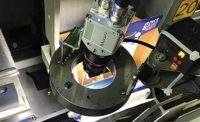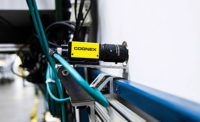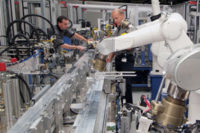Do You Need 3D Vision Guidance?

A FANUC six-axis robot equipped with a 3D vision sensor locates and picks randomly located parts from a storage container.
Photo courtesy FANUC Robotics

A vacuum gripper is a good tool for bin-picking because it minimizes disruption of the other parts and it automatically confirms that a part has been picked successfully. Photo courtesy FANUC Robotics

As an alternative to a vision-guided robot, ATC Automation designed a partially manual, mechanically driven process that would move the parts through a series of parallel rails to force them into a singular path. This path would present the parts to a pick-and-place unit. Photo courtesy ATC Automation

A FANUC six-axis robot equipped with a 3D vision sensor locates and picks randomly located parts from a storage container. Photo courtesy FANUC Robotics




Integrating new technologies into custom automated assembly systems can sometimes be daunting. It can require many hours of research, development and engineering to verify the validity of the concept.
ATC Automation recently did just that by completing an engineering study for a customer in the life science industry. The customer presented the task of isolating and orienting thin cylindrical parts from a bin as the first step of an optimized assembly process. Preventing deformation or damage to the parts throughout the feeding process was of utmost importance. However, that was going to be particularly challenging because of the delicacy of the parts.
After some discussion to fully understand the customer’s current processes and needs, ATC Automation proposed two possible solutions.
The first was a partially manual, mechanically driven process that would move the parts through a series of parallel rails to force them into a singular path. This path would present the parts to a pick-and-place unit that would then divide and present the parts to the first step of the assembly process.
The second option used a 3D vision array in conjunction with a six-axis robot. The 3D vision system would locate the part that could most easily be segregated, and the robot would pick it up and place it into a nest.
Although 2D vision systems are used extensively throughout the automation industry, 3D vision systems are relatively new, and their capabilities vary extensively. In light of the many possible challenges associated with such a complex system, the customer asked us to research and document this possibility in depth.
System Setup
We chose FANUC Robotics to partner with us on this project because of the company’s knowledge and experience regarding robotic vision systems—especially 3D vision systems.
The first step in this process was to establish the viability of the vision system. We used robotic simulation software to identify the best way to identify and locate the parts, as well as to do a basic time study of the process.
Two steps were necessary for the vision process: acquiring the 3D area map and locating the individual parts. Since the robot had to be clear of the bin for both of these processes, the vision process would take place while the robot was placing the previously picked part. If more time was needed, the robot would dwell outside the vision area and wait for the part location to be relayed.
Two overhead cameras provided an image, which was then used by the vision software’s “curved surface matching tool” to locate the parts. This tool uses gradients of light to dark in the image to distinguish the position of curved surfaces.
After locating a pickable part, analysis was done to locate the part’s center of gravity and to ensure there was room on either side of the part for the robot’s grippers. The part’s center of gravity corresponds with its location along the Z axis in space. That, together with the data obtained from the curved surface match, provides an exact pick point for the robotic arm.
FANUC suggested dividing the inspection area of the bins along the Y axis into quadrants to reduce cycle time. This greatly reduced the time required for data acquisition by the vision system, and it was essential to achieve to desired cycle time.
Up to this point, all the research was done with simulation software. The next stage of development was to introduce the robotic arm into the system. We needed to test the accuracy of the found location, the ability of the tooling, and the interaction of the parts between picks. Because the parts were stacked and shifted with each pick, the vision system had to analyze the parts between every pick.
ATC Automation designed and manufactured the gripper tooling, and FANUC Robotics provided the control program for the robotic arm. Our original concept included a gripper on the end of arm tooling, but that was found to be too rigid because of the need for precise location after gripping. In addition, we found that the parts would often shift when agitated by the gripper fingers. This would result in a missed pick, which, in turn, reduced cycle time.
Our second iteration of the tooling introduced a suction system prior to gripping, which added compliance into the process. The addition of suction also enabled the system to verify a successful pick through a vacuum switch.
After part presence was confirmed by vacuum, the robotic arm would extract the part from the bin, and a secondary gripper would ensure it was precisely held in place. The part could then be placed on the line in any orientation to facilitate design of the assembly process.
On Second Thought…
Together, ATC Automation and FANUC were able to realize a savings of 30 percent on cycle time and create a system that could locate, pick and place the parts. However, the system was deemed to be less robust than needed. In addition, there was some concern that accuracy concerns could damage the parts. Missed picks were too frequent, and the cycle time could not be reduced adequately to compensate for them. The possibility also existed that because of the nature of the parts, more than one part could be picked. This extra part could be dropped outside the bin or interfere with the robot when it tried to place a picked part.
In light of these concerns, ATC Automation could not recommend the 3D vision system to the customer. Ultimately, the customer chose to adopt the more manual and mechanically driven option, the benefits of which included versatility and utilization of available manpower.
As a direct result of our study, the customer was at least able to consider this new technology and develop a process that fit its needs completely.
Although 3D vision was not a fit in this application, the potential for the technology continues to grow. As the technology matures and becomes more accurate, so, too, will the potential applications.
With any project, ATC Automation ensures that new technologies, such as 3D vision systems, are thoroughly considered and properly applied through engineering studies. This reduces process risk for our customers and provides the best overall solution for each application.
For more information on automated assembly systems, 3D vision or robotics, call ATC Automation at 931-528-5417 or visit www.automationtool.com.
Looking for a reprint of this article?
From high-res PDFs to custom plaques, order your copy today!










